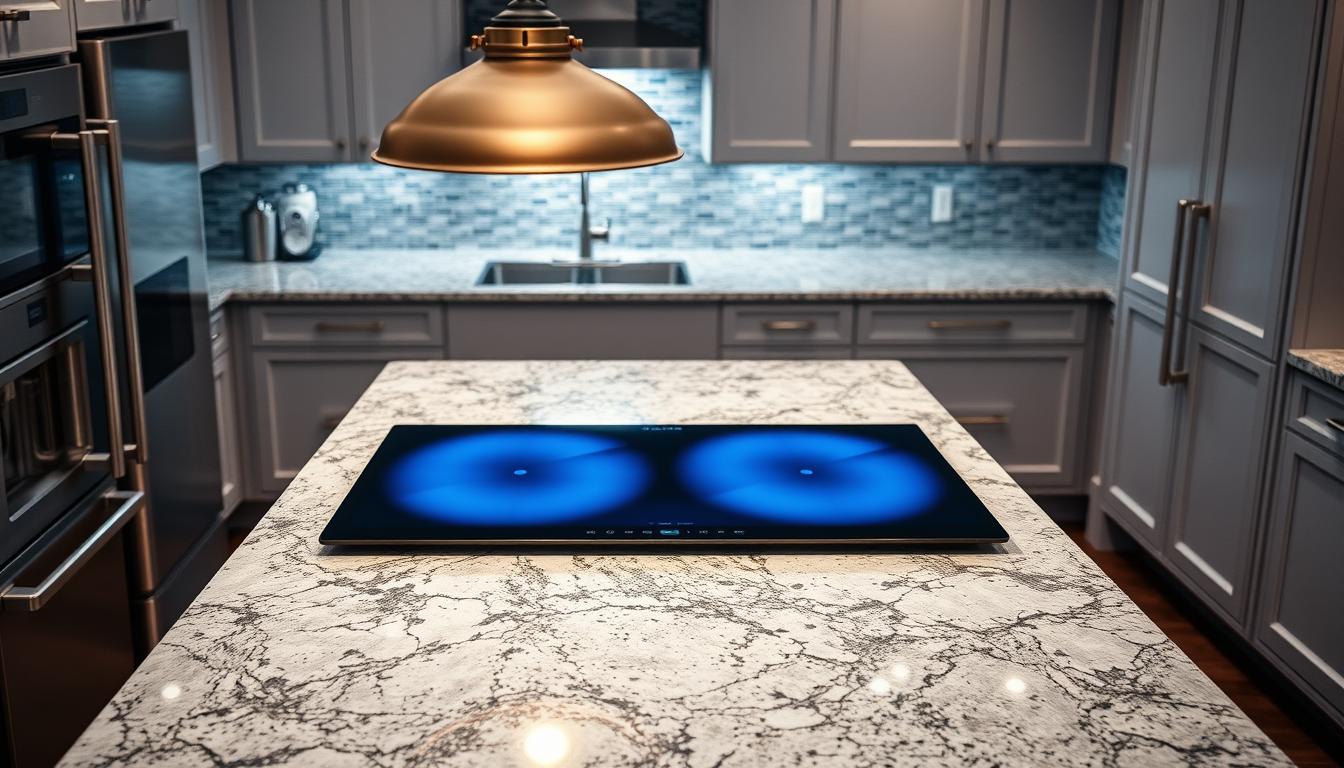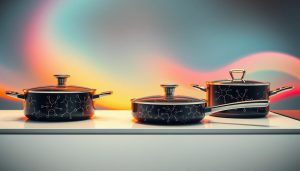Choosing the best cooktop for your kitchen can be tough. There’s a big debate between induction and gas cooktops. Did you know nearly 70% of homeowners look for energy efficiency in cooking appliances?
Induction cooktops are great for saving energy and are safe. They’re a popular choice for many. Gas cooktops, on the other hand, give you precision temperature control. They also offer a traditional cooking experience that chefs love.
When deciding, think about the good and bad of each cooktop. This article will guide you. We’ll look at the main differences between induction and gas cooktops.
Key Takeaways
- Energy efficiency comparison between induction and gas cooktops
- Safety features of induction cooktops
- Precision temperature control offered by gas cooktops
- Traditional cooking experience with gas cooktops
- Factors to consider when choosing the best cooktop for your kitchen
The Evolution of Kitchen Cooking Technology
Kitchen cooking technology has changed a lot, moving from old ways to new, efficient ones. This change came from new tech and what people want, leading to many cooking tech options.
From Open Flames to Modern Cooking Solutions
The start of kitchen tech was with open flames. Now, we have induction cooktops and gas cooktops. Each has its own good points and meets different cooking needs.

The Rise of Induction Technology
Induction cooking is getting more popular because it’s energy-saving and safe. It heats cookware directly with electromagnetic tech, cooking fast and accurately. Many home cooks like it for its ease and speed.
The Enduring Popularity of Gas Cooktops
Gas cooktops are also loved, even with induction’s rise. They let you control the heat well and offer a cooking feel that’s hard to beat with other tech.
| Cooking Technology | Key Features | Benefits |
|---|---|---|
| Induction Cooktops | Electromagnetic heating, energy efficiency | Fast cooking, safety features |
| Gas Cooktops | Precise temperature control, traditional cooking experience | Versatility, instant heat adjustment |
Today, we have many kitchen cooking tech options, from induction to gas. Knowing the differences helps you choose the right one for your cooking style.
Understanding How Gas Cooktops Work
Gas cooktops work by using natural gas or propane to create a flame. This flame directly heats your cookware. It’s all about the science of combustion and how the burners are designed.
The Science Behind Gas Flames
Gas flames work through combustion. When gas is ignited, it mixes with oxygen to produce heat and light. This process lets you control the heat precisely.
Gas Burner Components and Design
The design of gas burners is key to a cooktop’s performance. The burner cap, head, and base spread the flame evenly. Different designs, like simmer burners and high-power burners, let you cook in various ways.

BTU Ratings and What They Mean
BTU ratings show a burner’s heat output. A higher rating means more heat. Knowing BTU ratings helps you pick the right cooktop for your needs.
| BTU Rating | Cooking Task |
|---|---|
| Low (1,000-5,000 BTU) | Simmering, melting |
| Medium (5,000-10,000 BTU) | Searing, sautéing |
| High (12,000+ BTU) | High-heat cooking, boiling large quantities |
Understanding gas cooktops shows their benefits. They offer precise heat control and can cook a wide variety of dishes.
The Technology Behind Induction Cooking
Induction cooking uses a smart electromagnetic system. It heats your cookware directly, without needing a flame or electric coil.
Electromagnetic Principles of Induction
Induction cooking works by using electromagnetic fields to heat up. When you put compatible cookware on an induction cooktop, it creates an electromagnetic field. This field makes an electrical current in the cookware, which then turns into heat because of resistance.
How Induction Creates Heat
The heat from induction cooking is fast and efficient. The electromagnetic field makes currents in the cookware, and the material’s resistance turns this energy into heat. This method allows for quick heating and precise temperature control. It makes induction cooking great for many cooking methods.

The Role of Compatible Cookware
Compatible cookware is key for induction cooking. It must be made of ferromagnetic materials like cast iron or stainless steel to heat up. Not all cookware is compatible; you must check if your pots and pans have a ferromagnetic bottom to work with an induction cooktop.
Induction cooking is efficient, safe, and performs well. It’s a great choice for many home cooks. Knowing how induction cooking works helps you see its induction cooktop benefits and how it can improve your cooking.
Cooking Performance Comparison
Choosing between induction and gas cooktops means looking at their cooking performance. Each has its own strengths and weaknesses. These can greatly affect your cooking experience.
Heating Speed and Response Time
Induction cooktops heat up quickly and respond fast. They can boil water up to 50% faster than gas cooktops. This makes them great for tasks that need fast heating. Gas cooktops, while slower, offer a traditional cooking feel with a visible flame.
Temperature Control and Precision
Induction cooking gives you precise temperature control. This is perfect for delicate cooking. Gas cooktops also control temperature well, but the precision can depend on the burner and cookware quality.

Heat Distribution Characteristics
Induction and gas cooktops distribute heat differently. Induction cooktops heat cookware directly, leading to efficient heat transfer and less energy loss. Gas cooktops heat through an open flame, which can cause some heat loss around the cookware.
Cooking Versatility
Both induction and gas cooktops are versatile for cooking. Induction is good for simmering, boiling, and frying. Gas cooktops are loved by chefs for their visual heat adjustment and are often preferred by professionals.
In conclusion, picking between induction and gas cooktops depends on your cooking needs and preferences. Knowing the strengths and weaknesses of each helps you choose the best for your cooking experience.
Energy Efficiency and Environmental Impact
When choosing a cooktop, it’s key to look at energy use and the environment. This part talks about how induction and gas cooktops stack up in these areas.
Energy Consumption Metrics
Induction cooktops use less energy than gas ones. They can be up to three times more efficient. This is because they heat cookware directly, losing less energy.
Energy consumption metrics show induction cooktops use 85-90% of electrical energy for cooking. Gas cooktops only use 40-50%. This big difference affects how much energy and money you use.
Carbon Footprint Considerations
The carbon footprint of induction and gas cooktops depends on the energy source. Induction is better if the electricity comes from clean sources. This makes it more eco-friendly.
Gas cooktops use natural gas, a fossil fuel. While cleaner than coal or oil, it also emits greenhouse gases during use.
Heat Loss Comparison
Heat loss is important for cooktop efficiency. Induction cooking loses less heat because it heats the cookware directly. Gas cooktops lose more heat due to the flame and space.

Environmental Sustainability
Looking at environmental sustainability, consider the whole life of the cooktop. Induction is more efficient and might have a lower carbon footprint in areas with clean energy. This makes it a good choice for those caring about the planet.
- Induction cooktops offer higher energy efficiency.
- Gas cooktops rely on fossil fuels, contributing to emissions.
- The environmental impact of induction cooking is influenced by the electricity generation mix.
In summary, choosing between induction and gas cooktops is about energy use and the environment. As energy policies and personal choices change, knowing these details helps homeowners make better choices for their homes and the planet.
Cost Analysis: Purchase, Installation, and Operation
When deciding between induction and gas cooktops, it’s important to look at the costs. This helps you understand the financial impact of your choice. It’s key to making a smart decision.
Initial Purchase Price Ranges
The cost of induction and gas cooktops varies a lot. It depends on the brand, model, and features. Induction cooktops can cost between $800 and $2,500. Gas cooktops range from $500 to $2,000. The most advanced models are the priciest.

Installation Requirements and Costs
Installation costs can add up. Gas cooktops need a gas line, which can cost $100 to $500. Induction cooktops require an electrical circuit. This might cost $100 to $300, depending on the complexity.
Long-term Operating Expenses
Think about the long-term costs too. Induction cooktops are more energy-efficient, using up to 90% of energy. Gas cooktops use about 40-50%. The U.S. Energy Information Administration says electricity costs about 12 cents per kilowatt-hour. Natural gas is around $1.10 per therm.
“Energy efficiency is a key factor in reducing long-term operating expenses.”
Return on Investment Considerations
Consider the long-term savings when thinking about investment. Induction cooktops might cost more upfront but save money on energy bills. A study by the American Council for an Energy-Efficient Economy shows energy-efficient appliances save money over time.
By looking at these factors, you can choose wisely. This choice should fit your budget and cooking style.
Safety Features and Concerns
Kitchen safety is very important. Knowing the safety features of induction and gas cooktops helps you make a good choice. Each type has its own safety benefits and risks.
Fire and Gas Leak Risks with Gas Cooktops
Gas cooktops can be risky, with chances of fires and gas leaks. A gas leak might happen if the cooktop is not installed right, if regulators are faulty, or if gas lines are damaged. Getting a professional to install your gas cooktop and checking the gas lines often can help avoid these dangers. Many modern gas cooktops also have safety features like automatic shut-off in emergencies.
Burn Prevention with Induction Technology
Induction cooktops are safer because they lower the risk of burns. They only heat up when a compatible pot or pan is on the surface. This makes it safer to be around the cooking area because the surface stays cool.

Child Safety Considerations
For families with kids, safety is key. Induction cooktops often have child safety locks to stop accidents. Gas cooktops can also be safe with the right precautions and watching the kids closely.
Emergency Shutdown Features
Both induction and gas cooktops have emergency shutdowns. Induction cooktops turn off automatically if there’s a problem or if a pot is taken off. Some gas cooktops also have this feature, but it’s less common. Knowing and using these features can make your kitchen safer.
In summary, both induction and gas cooktops have safety concerns. But, by understanding these risks and using the safety features, you can make your kitchen safer. Choosing the right cooktop and knowing its safety profile helps create a safer cooking space.
Induction vs. Gas Cooktops: What’s Right for You?
Your cooking style, kitchen layout, and personal preferences are key in choosing between induction and gas cooktops. It’s important to think about several factors that affect your choice.
Matching Cooktop Type to Cooking Style
What you cook most often should guide your choice. If you love cooking and need precise temperature control, gas cooktops might be best. They offer a continuous flame and quick heat changes.
On the other hand, if you focus on energy efficiency and quick heating, induction cooking could be better. It heats up fast and is energy-efficient.
Cooks who use woks or large pots might prefer gas. It works well with many cookware sizes and types. Induction is great for those who value fast cooking and easy cleaning.
Kitchen Space and Ventilation Requirements
The layout and ventilation of your kitchen matter a lot. Gas cooktops need good ventilation to remove harmful gases. This might mean a stronger ventilation system is needed.
Induction cooktops, being cleaner and less hot, offer more kitchen design flexibility. They also need less ventilation.

Household Composition Considerations
The size and makeup of your household can also affect your choice. Induction cooktops are safer for households with young children. They have automatic shut-off and cooler surfaces.
For bigger families or when cooking for guests often, gas cooktops might be better. They provide high heat and flexibility with multiple burners.
Regional Factors and Utility Availability
Your location and the availability of utilities also play a role. In places where electricity is reliable and cheap, induction might be more practical. But in areas with frequent power outages or well-established gas infrastructure, gas cooktops could be better.
| Factor | Induction Cooktops | Gas Cooktops |
|---|---|---|
| Cooking Style | Ideal for quick heating and energy efficiency | Preferred for precise temperature control and continuous flame |
| Kitchen Ventilation | Less demanding ventilation requirements | Requires robust ventilation to remove combustion byproducts |
| Household Safety | Safer with automatic shut-off and cooler surfaces | Potential fire hazard if not monitored |
| Regional Utility | Dependent on reliable electricity | Suitable for areas with well-established gas infrastructure |
Choosing the right cooktop for your kitchen is about balancing several factors. Think about your cooking habits, kitchen layout, household needs, and local utility options. This way, you can make a choice that fits your lifestyle.
The Cooking Experience: Chef and Home Cook Perspectives
Professional chefs and home cooks have different views on induction and gas cooking. Their experiences can help you decide between these two options.
Professional Chef Preferences
Professional chefs love precision and control in their cooking. They often choose gas cooktops for their instant heat and visual flame. But, many are now using induction cooking for its rapid heating capabilities and precise temperature control.
Some top restaurants use induction cooking for its efficiency and steady temperatures.
Home Cook Satisfaction Surveys
Home cooks value ease of use and safety. Surveys show they like the safety features of induction cooktops, like automatic shut-off. Yet, some prefer gas cooking for its feel and flame visibility.

Learning Curve Comparison
Induction cooking has a steeper learning curve. It needs special cookware and a different heating method. Gas cooking, being more familiar, is easier for many.
Cooking Technique Adaptations
Switching between induction and gas cooking requires technique adjustments. Induction cooking needs a new heat pattern, while gas cooking supports traditional methods like wok cooking.
Cookware Compatibility and Considerations
Switching to a new cooktop can change how you cook. It’s key to know if your cookware works with your new cooktop. This is true for induction or gas cooktops.
Induction-Compatible Materials
Induction cooktops need cookware that’s magnetic, like cast iron or stainless steel. The induction cooktop benefits include fast heating and control. But, you need the right cookware to enjoy these perks.

Ideal Cookware for Gas Cooking
Gas cooktops are more flexible with cookware. You can use many materials, like stainless steel, cast iron, or even copper. Just make sure they have a flat bottom for stability.
Adapting Your Existing Cookware Collection
Switching to induction? Check your cookware first. Glass, ceramic, and some stainless steel or aluminum won’t work. You might need to get new cookware or use an induction disk.
Investment in New Cookware
Gas cooktops let you use a variety of cookware. But, should you buy new? If you want the induction cooktop benefits, like saving energy and controlling heat, new cookware might be a good choice.
Maintenance and Cleaning Requirements
Both induction and gas cooktops need regular care to work well. How easy they are to maintain and clean can help you decide between them.
Daily Cleaning Procedures
Cleaning your cooktop every day keeps it looking and working great. Gas cooktops need you to wipe down grates and burner caps often. Gas cooktop advantages include easy part replacements like burner caps and grates.
Induction cooktops have a smooth surface that’s easy to clean with a damp cloth. But, they need extra care to avoid scratches.

Long-term Maintenance Needs
As time goes on, both cooktops need more than daily cleaning. Gas cooktops might need burner cleaning or replacement, and igniter checks.
Dealing with Spills and Boilovers
Spills and boilovers happen in every kitchen. For gas cooktops, clean spills right away to avoid clogging burners. Induction cooktops are easier to handle because they don’t have open flames or burners that can get clogged.
Lifespan and Durability Expectations
| Cooktop Type | Average Lifespan | Durability Factors |
|---|---|---|
| Gas Cooktop | 15-20 years | Quality of construction, maintenance frequency |
| Induction Cooktop | 10-15 years | Electronic component quality, usage patterns |
Knowing these details helps you choose the right cooktop for your needs and preferences.
Design and Kitchen Aesthetics
Induction and gas cooktops differ in cooking tech and looks. They also affect your kitchen’s style. The design of your cooktop greatly influences your kitchen’s overall look.
Visual Impact on Kitchen Design
The look of a cooktop is key in kitchen design. Induction cooktops have a sleek, modern style. They fit well with modern kitchens and can be mounted flush with countertops.
Available Styles and Finishes
Both induction and gas cooktops come in many styles and finishes. Induction cooktops often have glass or ceramic surfaces in various colors and designs. Gas cooktops offer stainless steel, cast iron, or enameled grates for different looks.
Space Requirements and Layout Considerations
Think about your kitchen’s space and layout when picking a cooktop. Gas cooktops need more room for ventilation. Induction cooktops are more flexible in installation.
Integration with Kitchen Decor
Choose a cooktop that matches your kitchen’s decor. It should blend with cabinets, countertops, and appliances. This ensures a harmonious kitchen, making it the best cooktop for your kitchen.
Special Features and Smart Technology
Today’s cooktops are more than just cooking tools. They offer smart features that make cooking better and easier. Whether you choose induction or gas, you’ll find advanced features that enhance your cooking experience.
Smart Home Integration Options
Smart home integration is a big leap in cooktop technology. Many modern induction and gas cooktops connect to your Wi-Fi. This lets you control them with your smartphone app, even when you’re not in the kitchen.
Programmable Cooking Functions
Both induction and gas cooktops now have programmable functions. For example, some induction cooktops let you set exact temperatures and timers. This ensures your food is cooked just right. Gas cooktops also have features like automatic ignition and flame control.
Safety Automation Features
Safety is key in today’s cooktops. They come with features like automatic shut-off and pan detection. Induction cooktops have extra safety features, like child safety locks and overheat protection.
Unique Capabilities of Each Cooktop Type
Induction and gas cooktops have their own special features. Induction cooktops offer precise temperature control and fast heating. Gas cooktops give a traditional cooking feel with instant flame adjustment.
When picking between induction and gas, think about what you need. Do you want smart home integration, programmable cooking, or safety features? There’s a cooktop out there that’s right for you.
Future Trends in Cooktop Technology
Future cooktop technology will change how we cook, making it more efficient and green. The industry is moving fast, with exciting new things coming.
Innovations in Induction Cooking
Induction cooking is getting better, with smart features and precise temperature control. These updates make cooking faster, more convenient, and use less energy.
- Advanced induction coils for faster heating
- Improved cookware compatibility detection
- Integration with smart home systems for seamless control
Developments in Gas Cooktop Efficiency
Gas cooktops are also improving, focusing on being more efficient and safe. New models have better ignition systems and burner designs. These changes cut down gas use and emissions.
“The future of gas cooking lies in its ability to balance performance with environmental responsibility.” –
Hybrid Solutions Emerging in the Market
Hybrid cooktops are a big deal, blending induction and gas cooking. They offer the best of both worlds: precision and efficiency of induction, plus the traditional gas cooking feel.
Sustainability Initiatives Shaping Future Designs
Sustainability is key in cooktop design now. Makers are working to use less energy and be kinder to the planet. They’re using eco-friendly materials and making designs that last longer and can be recycled.
| Feature | Induction Cooktops | Gas Cooktops |
|---|---|---|
| Energy Efficiency | High | Moderate |
| Cooking Precision | High | High |
| Environmental Impact | Low | Moderate |
As these trends grow, cooking will get better, greener, and more fun.
Conclusion
Choosing between induction and gas cooktops depends on your cooking style, kitchen space, and what you like. Induction cooking is efficient, controls temperature well, and looks modern. Gas cooktops offer quick heat, a traditional feel, and work with many types of pots and pans.
Think about what you need before making a decision. If you want fast, precise cooking and save energy, induction might be right. But if you like the old-school cooking feel and don’t mind using more energy, gas could be better.
Looking at the good and bad points of each will help you decide. Consider how well they cook, how much energy they use, their cost, safety, and design. This way, you can pick the cooktop that fits your cooking style and needs.



